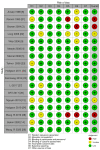Efficacy of Higher Positive End-Expiratory Pressure Ventilation Strategy in Patients With Acute Respiratory Distress Syndrome: A Systematic Review and Meta-Analysis
- PMID: 35989808
- PMCID: PMC9382348
- DOI: 10.7759/cureus.26957
Efficacy of Higher Positive End-Expiratory Pressure Ventilation Strategy in Patients With Acute Respiratory Distress Syndrome: A Systematic Review and Meta-Analysis
Abstract
Previous systematic reviews and meta-analyses assessing the pooled effects of higher positive end-expiratory pressure (PEEP) failed to show significantly reduced mortality in patients with acute respiratory distress syndrome (ARDS). Some new randomized controlled trials (RCTs) have been reported and an updated systematic review is needed to evaluate the use of higher PEEP in patients with ARDS. We searched MEDLINE, Cochrane Central Register of Controlled Trials (CENTRAL), EMBASE, Cumulative Index to Nursing and Allied Health Literature (CINAHL), Igaku-Chuo-Zasshi, ICTRP, the National Institute of Health Clinical Trials Register, and the reference list of recent guidelines. We included RCTs to compare the higher PEEP ventilation strategy with the lower strategy in patients with ARDS. Two authors independently assessed the eligibility of the studies and extracted the data. The primary outcomes were 28-day mortality. The GRADE (Grading of Recommendations, Assessment, Development, and Evaluations) methodology was used to evaluate the certainty of the evidence. Among the 6530 screened records, 16 randomized trials involving 4150 patients were included in our meta-analysis. When comparing higher PEEP versus lower PEEP, the pooled risk ratio (RR) for 28-day mortality was 0.85 (15 studies, n=4108, 95% CI 0.72 to 1.00, I2=58%, low certainty of evidence). Subgroup analysis by study participants with a low tidal volume (LTV) strategy showed an interaction (P for interaction, 0.001). Our study showed that in patients with ARDS, the use of higher PEEP did not significantly reduce 28-day mortality compared to the use of lower PEEP.
Keywords: acute respiratory distress syndrome [ards]; ards (acute respiratory distress syndrome); invasive mechanical ventilation; peep; peep - positive end expiratory pressure; severe ards; systematic review and meta analysis; ventilator induced lung injury.
Copyright © 2022, Yamamoto et al.
Conflict of interest statement
The authors have declared that no competing interests exist.
Figures






References
-
- Evolution of mechanical ventilation in response to clinical research. Esteban A, Ferguson ND, Meade MO, et al. Am J Respir Crit Care Med. 2008;177:170–177. - PubMed
-
- The ALIEN study: incidence and outcome of acute respiratory distress syndrome in the era of lung protective ventilation. Villar J, Blanco J, Añón JM, et al. Intensive Care Med. 2011;37:1932–1941. - PubMed
-
- Higher versus lower positive end-expiratory pressures in patients with the acute respiratory distress syndrome. Brower RG, Lanken PN, MacIntyre N, et al. N Engl J Med. 2004;351:327–336. - PubMed
-
- Ventilation strategy using low tidal volumes, recruitment maneuvers, and high positive end-expiratory pressure for acute lung injury and acute respiratory distress syndrome: a randomized controlled trial. Meade MO, Cook DJ, Guyatt GH, et al. JAMA. 2008;299:637–645. - PubMed
-
- Positive end-expiratory pressure setting in adults with acute lung injury and acute respiratory distress syndrome: a randomized controlled trial. Mercat A, Richard JC, Vielle B, et al. JAMA. 2008;299:646–655. - PubMed
Publication types
LinkOut - more resources
Full Text Sources
